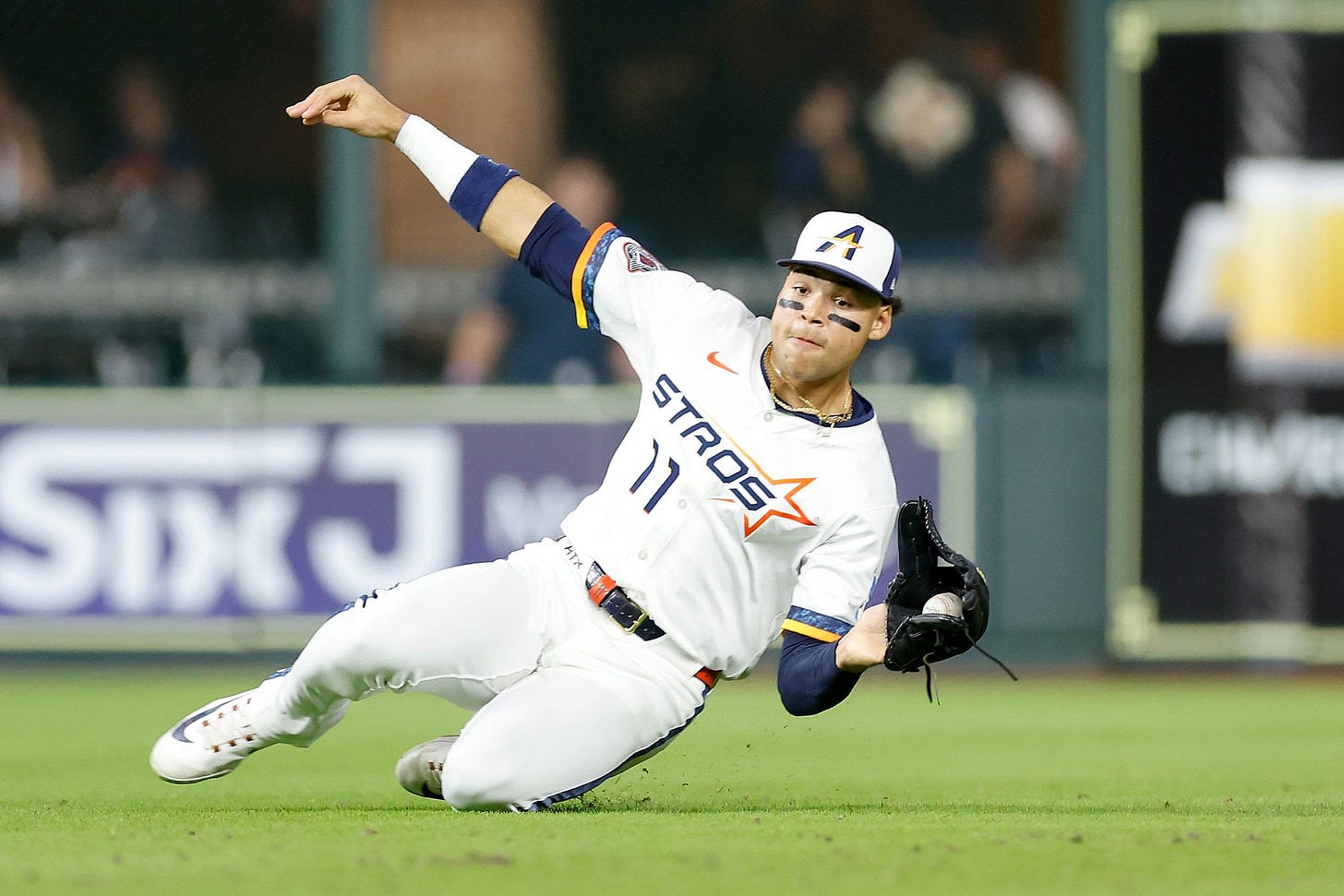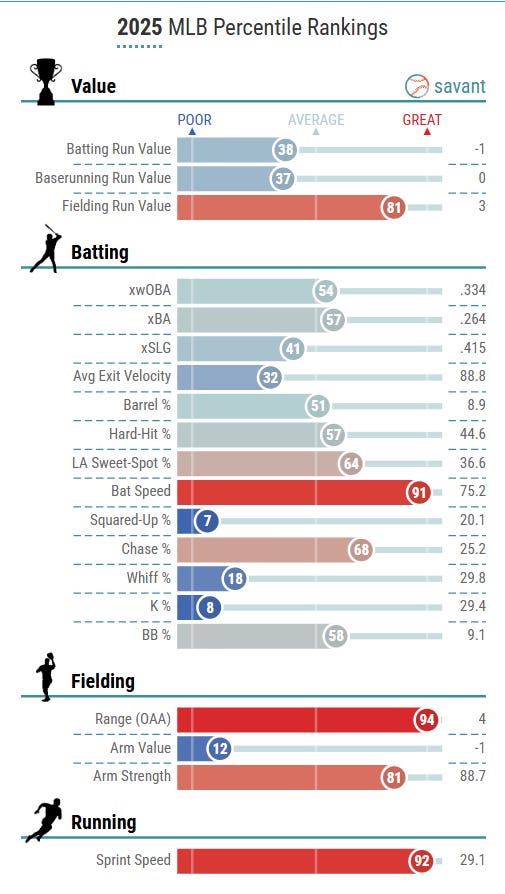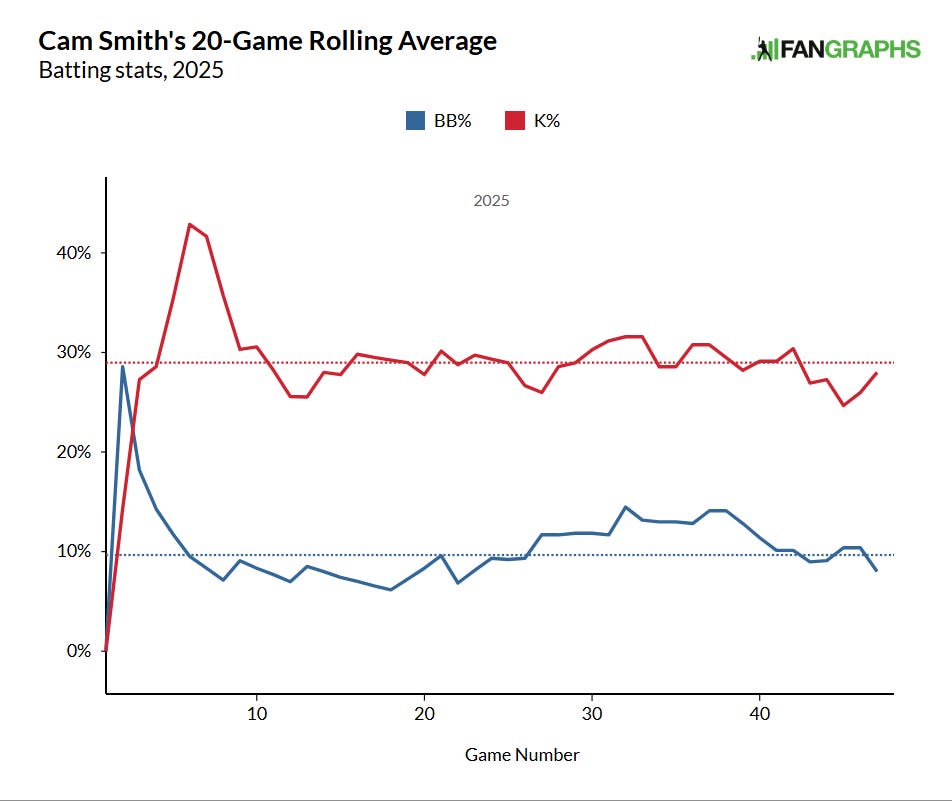The Cam Smith Experiment is Working...for the Most Part
Smith's high-quality defense and slowly but surely improving game at the plate indicates that his quick promotion to the majors has not stunted his development as a player.
When Cam Smith made the opening day roster, most Astros fans seemed excited. He was hot in Spring Training, they said. Many were emotional at the video the Astros posted on social media of Smith’s family informing him that he made the Opening Day roster. The vibes were good.
But I was taken in by the vibes. Instead, I posted that I was “skeptical” that a call up of a prospect with only 32 games of minor league experience would work. It seemed to me unlikely that Smith could handle the major leagues after so little experience in the minors. I worried that Smith failing at the major league level would stunt his growth, and he would be better off dominating in Corpus Christi before he got the call to the majors.
I did note at the end of that skeet that “I hope that I am wrong.” It is too early to declare that I was wrong to think that Smith should start in the minors. But early returns indicate that the Cam Smith experiment is working and that the Astros are benefitting from having him in the everyday lineup.
Smith has recorded 1.1 bWAR over the season’s first 65 games. That is 4th best among Astros position so far this season, behind Jeremy Pena, Isaac Paredes, and Jake Meyers. It is on pace for 2.7 wins above replacement over the course of the season, which is well above the standard of 2.0 for the average major leaguer.
A Natural Outfielder, Apparently
Most of Smith’s value comes from his defense. And that is quite shocking to me, as Smith had played third base almost exclusively until the Astros moved him to right field in Spring Training this season.
He has taken to it quite naturally. Statcast numbers show that Smith is very good at getting “a jump” on the ball in right field. He covers, on average, 36.1 feet in the first three seconds after a ball is it. That’s 17th best among all major league outfielders this season. Notably to me, that’s nearly 2 feet better than Jake Meyers—the Astros best defensive outfielder—has achieved this this year.
Smith’s ability to get a good jump on the ball has produced more outs. Statcast says he has caught 90% of balls of fly balls hit to right field this year, while the average major league right fielder would have caught only 87% of those balls. As a result, he has produced 4 Outs Above Average in right field, which is 17th best among Major League outfielders this season.
Smith’s good defensive numbers are not a creation of a single defensive metric. Sports Information Solutions credits Smith with 7 Defensive Runs Saved, which is 11th best in the majors. On Fielding Runs Above Average, Smith is credited with +12 runs, the second best rate in baseball.
What’s notable about Smith’s outfield defense is how new he is to the position. Smith played third base at Florida State and in his cup of coffee in the minors in 2024. He is very new to the position, yet he looks like a natural out there.
League Average Offense
On the hitting side, Smith has battled major league pitching to a draw so far. He is slashing .246/.326/.365 for a .691 OPS. Thos numbers have produced a a weighted Runs Created Plus for Smith of 101. That means he is 1% better than league average as a hitter. So almost exactly league average.
The percentile rankings at Baseball Savant help show a player’s individual skills, particularly at the plate. Smith has an above average walk rate but a below average rate in whiff % and K%. That is, he swing-and-misses too often.
Also, when Smith does make contact, it is rare for him to square up the ball with his bat. He is at the 9th percentile in that ranking. In short, he’s not making enough good contact with the ball.
But when he does get to the ball, he does pretty well with it. His hard hit rate and barrel rates are just above league average. My assessment of these numbers is that Smith is struggling to adjust to major league pitching because that is of course hard to do. But he does make contact with the ball, he can hit it hard.
Thus, Smith needs to make more contact. When he does, he can access his natural power—his bat speed is at the 91st percentile for all major leaguers. I would expect him to make adjustments to do this more frequently the more major league pitching that he sees.
Signs of Improvement
Looking deeper into his numbers, I think there are good reasons to think that Smith will hit better in the second half of the season. In fact, there are signs that he is already doing so.
This graph examines Smith’s expected weighted On Base Average (xwOBA), which is a comprehensive measure of a player’s batting skills, based on the quality of contact hie is making at the plate. One can see that Smith’s wOBA has tended to go up over the course of the season. In short, Smith has been improving, slowly but steadily, at the plate over the course of the season so far.
How has he been doing that? One answer is that he has been decreasing his strikeout rate over the course of the season, while increasing his walk rate. These changes are gradual, but one can see how Smith’s strikeout rate has declined, especially over the last month of the season. Similarly, his walk rate was on an upward trajectory for most of the season, though it has declined in the most recent few days.
Smith struck out in 29.4% of his plate appearances in April. He reduced that to 25.9% in May. Both numbers are higher than the major league average strikeout rate of 22.0%, but the decline shows Smith’s improvement, even over a relatively short period of time.
Smith has decreased his strikeout rate because he has reduced his rate of swing-and-miss. The blue line below shows a gradual but pretty steady decline in Smith’s swinging strike rate. Less swing-and-miss means more contact. And Smith’s contact rate has been rising over the course of the season. In short, he’s hitting the ball more often.
And not only is Smith hitting the ball more often, he is hitting the ball harder. This chart shows Smith’s hard hit percentage over the course of the season. You can see the steady improvement over the first part of the season and then the big increase in recent weeks. Hitting the ball hard is of course a very good thing for a hitter.
Smith has slumped so far in the month of June, but he has had only 17 plate appearances. That’s probably just a brief cold snap for Smith. It is too small of sample to analyze much.

Raw Skills That Need Refinement
Smith is a player with excellent raw athletic skills. He has excellent speed—both with his feet and swinging a bat. He has used his speed to develop into a very good defensive outfield in his first real exposure to the position. He uses hit foot speed to get to balls other outfielders would not.
The numbers actually show that Smith is more average in reading balls off of the bat and below average in the routes he takes to batted balls. Those numbers are not surprising for a player so new to the outfield, and show the potential for improvement as he gets more experience tracking fly balls from right field.
We see something similar with his skills at the plate. Smith’s excellent bat speed allows him to hit the ball hard and he can barrel it up when he really gets to a ball. But he does not do that often enough, doing poorly at squaring up the ball. His high rate of chasing pitchers and swinging-and-missing hampers his ability to use his natural power.
Despite those flaws, the numbers show he is slowly but surely improving in his brief time in the majors. There are good reasons to think he will be a better hitter in the second half of the season.
I was worried that Smith’s lack of minor league experience would stunt his development path as a player. To Smith’s credit and to the Astros benefit, it does not look that that his happening. Smith has been a productive and—most importantly—an improving player so far in the majors.









Well written. Number support your assertions and I agree that he’s rapidly improving. Hopefully he keeps his 3rd base skill set in case we need them